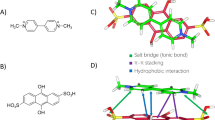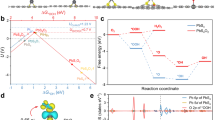Abstract
Here we describe 2,6-anthrahydroquinone disulfonate (AH2DS) as a model thermodynamically ‘targeting’ electron donor capable of selectively stimulating respiratory processes relevant to the bioremediation of perchlorate. Pure cultures of Dechloromonas aromatica, Dechloromonas agitata and Azospira suillum, as well as uncharacterized microbial consortia, were capable of stoichiometrically reducing perchlorate to chloride upon oxidation of AH2DS to the corresponding quinone 2,6-anthraquinone disulfonate (AQDS). No degradation of the anthraquinone structure was observed, and no organism tested grew by this metabolism. Thermodynamic calculations suggest that AH2DS oxidation should support nitrate and perchlorate reduction, whereas sulfate reduction and methanogenesis are predicted to be unfavorable. Mixed community microcosms oxidizing AH2DS reduced nitrate and perchlorate, whereas sulfate reduction never occurred. In contrast, microcosms amended with acetate respired nitrate, perchlorate and sulfate, as would be predicted by thermodynamic calculation. Our results suggest that the thermodynamic properties of hydroquinones allow for targeted stimulation of only a subset of potential respiratory processes. This observation could help improve enhanced in situ bioremediation of perchlorate by negating many of the detrimental aspects of biofouling.
Similar content being viewed by others
Log in or create a free account to read this content
Gain free access to this article, as well as selected content from this journal and more on nature.com
or
References
Bender KS, O’Connor SM, Chakraborty R, Coates JD, Achenbach LA . (2002). The chlorite dismutase gene of Dechloromonas agitata strain ckb: sequencing, transcriptional analysis and its use as a metabolic probe. Appl Environ Microbiol 68: 4820–4826.
Bruce RA, Achenbach LA, Coates JD . (1999). Reduction of (per)chlorate by a novel organism isolated from a paper mill waste. Environ Microbiol 1: 319–331.
Champ DR, Gulens J, Jackson RE . (1979). Oxidation-reduction sequences in ground water flow systems. Can J Earth Sci 16: 12–23.
Chapelle FH, Vroblesky DA, Woodward JC, Lovley DR . (1997). Practical considerations for measuring hydrogen concentrations in groundwater. Environ Sci Technol 31: 2873–2877.
Chaudhuri SK, Lack JG, Coates JD . (2001). Biogenic magnetite formation through anaerobic biooxidation of Fe(II). Appl Environ Microbiol 67: 2844–2848.
Chaudhuri SK, O’Connor SM, Gustavson RL, Achenbach LA, Coates JD . (2002). Environmental factors that control microbial perchlorate reduction. Appl Environ Microbiol 68: 4425–4430.
Cline JD . (1969). Spectrophotometric determination of hydrogen sulfide in natural waters. Limnol Oceanogr 14: 454–458.
Coates JD, Achenbach LA . (2001). The biogeochemistry of aquifer systems. In: Hurst CJ, Knudsen GR, McInerney MJ, Stetzenbach LD, Walter MW (eds). Manual of Environmental Microbiology. ASM Press: Washington, DC. pp 719–727.
Coates JD, Achenbach LA . (2004). Microbial perchlorate reduction: rocket-fuelled metabolism. Nat Rev Microbiol 2: 569–580.
Coates JD, Achenbach LA . (2006). The microbiology of perchlorate reduction and its bioremediative application. In: Gu B, Coates JD (eds). Perchlorate, Environmental Occurrence, Interactions, and Treatment. Springer Publishers: New York, NY, pp 279–291.
Coates JD, Chakraborty R, Lack JG, O’Connor SM, Cole KA, Bender KS et al. (2001a). Anaerobic benzene oxidation coupled to nitrate reduction in pure culture by two strains of Dechloromonas. Nature 411: 1039–1043.
Coates JD, Chakraborty R, O’Connor SM, Schmidt C, Thieme J . (2001b). The geochemical effects of microbial humic substances reduction. Acta Hydrochim Hydrobiol 28: 420–427.
Coates JD, Cole KA, Chakraborty R, O’Connor SM, Achenbach LA . (2002). The diversity and ubiquity of bacteria utilizing humic substances as an electron donor for anaerobic respiration. Appl Environ Microbiol 68: 2445–2452.
Coates JD, Ellis DJ, Blunt-Harris EL, Gaw CV, Roden E, Lovley DR . (1998). Recovery of humics-reducing bacteria from a diversity of environments. Appl Environ Microbiol 64: 1504–1509.
Coates JD, Jackson A . (2008). In situ bioremediation of perchlorate in groundwater. In: Ward CH, Stroo HF (eds). Principles of Perchlorate Treatment. Springer: Norwell, MA.
Coates JD, Michaelidou U, Bruce RA, O’Connor SM, Crespi JN, Achenbach LA . (1999). The ubiquity and diversity of dissimilatory (per)chlorate-reducing bacteria. Appl Environ Microbiol 65: 5234–5241.
Cunningham AB, Characklis W, Abedeen F, Crawford D . (1991). Influence of biofilm accumulation on porous media hydrodynamics. Environ Sci Technol 25: 1305–1310.
Doong R-A, Chiang H-C . (2005). Transformation of carbon tetrachloride by thiol reductants in the presence of quinone compounds. Environ Sci Technol 39: 7460–7468.
Ju X, Field JA, Sierra-Alvarez R, Salazar M, Bently H, Bently R . (2007). Chemolithotrophic perchlorate reduction linked to the oxidation of elemental sulfur. Biotechnol Bioeng 96: 1073–1082.
Khan IA, Spalding RF . (2003). Development of a procedure for sustainable in situ aquifer denitrification. Remediat J 13: 53–69.
Khan IA, Spalding RF . (2004). Enhanced in situ denitrification for a municipal well. Water Res 38: 3382–3388.
Kwon MJ, Finneran KT . (2006). Microbially mediated biodegradation of hexahydro-1,3,5-trinitro-1,3,5-triazine by extracellular electron shuttling compounds. Appl Environ Microbiol 72: 5933–5941.
Lack JG, Chaudhuri SK, Chakraborty R, Achenbach LA, Coates JD . (2002). Anaerobic biooxidation of Fe(II) by Dechlorosoma suillum. Microb Ecol 43: 424–431.
Lovley DR, Coates JD, Blunt-Harris EL, Phillips EJP, Woodward JC . (1996). Humic substances as electron acceptors for microbial respiration. Nature 382: 445–448.
Lovley DR, Fraga JL, Blunt-Harris EL, Hayes LA, Phillips EJP, Coates JD . (1998). Humic substances as a mediator for microbially catalyzed metal reduction. Acta Hydrochim Hydrobiol 26: 152–157.
Lovley DR, Fraga JL, Coates JD, Blunt-Harris EL . (1999). Humics as an electron donor for anaerobic respiration. Environ Microbiol 1: 89–98.
Lovley DR, Goodwin S . (1988). Hydrogen concentrations as an indicator of the predominant terminal electron-accepting reactions in aquatic sediments. Geochim Cosmochim Acta 52: 2993–3003.
Lovley DR, Phillips EJP . (1986). Availability of ferric iron for microbial reduction in bottom sediments of the freshwater tidal Potomac River. Appl Environ Microbiol 52: 751–757.
Miller JP, Logan BE . (2000). Sustained perchlorate degradation in a gas phase hydrogen-oxidizing packed bed bioreactor. Environ Sci Technol 17: 257–265.
Nerenberg R, Rittmann BE . (2004). Hydrogen-based, hollow-fiber membrane biofilm reactor for reduction of perchlorate and other oxidized contaminants. Water Sci Technol 49: 223–230.
O’Connor SM, Coates JD . (2002). A universal immuno-probe for (per)chlorate-reducing bacteria. Appl Environ Microbiol 68: 3108–3113.
Ponnamperuma FN . (1972). The chemistry of submerged soils. Adv Agron 24: 29–96.
Ponnamperuma FN . (1984). Effects of flooing on soils. In: Kozlowski TT (ed). Flooing and Plant Growth. Academic Press Inc.: New York, pp 9–45.
Prinz H, Strehblow HH . (1998). Investigations on pitting corrosion of iron in perchlorate electrolytes. Corrosion Sci 40: 1671–1683.
Seignez C, Adler N, Suard JC, Peringer P . (1996). Aerobic and anaerobic biodegradability of 1-anthraquinone sulphonate. Appl Microbiol Biotechnol 45: 719–722.
Stanbury JB, Wyngaarden JB . (1952). Effect of perchlorate on the human thyroid gland. Metabolism 1: 533–539.
Stookey LL . (1970). Ferrozine—a new spectrophotometric reagent for iron. Anal Chem 42: 779–781.
Taylor SW, Jaffe PR . (1990). Biofilm growth and the related changes in the physical properties of a porous medium: experimental investigation. Water Resources Res 26: 2153–2159.
Thrash JC, VanTrump JI, Weber KA, Miller E, Achenbach LA, Coates JD . (2007). Electrochemical stimulation of microbial perchlorate reduction. Environ Sci Technol 41: 1740–1746.
Vandevivere P, Baveye P . (1992). Saturated hydraulic conductivity reduction caused by aerobic bacteria in sand columns. Soil Sci Soc Am J 56: 1–13.
Weber KA, Achenbach LA, Coates JD . (2006). Microbes pumping iron: anaerobic microbial iron oxidation and reduction. Nat Rev Microbiol 4: 752–764.
Weber KA, Picardal FW, Roden EE . (2001). Microbially-catalyzed nitrate-dependent oxidation of biogenic solid-phase Fe(II) compounds. Environ Sci Technol 35: 1644–1650.
Wu J, Unz RF, Zhang H, Logan BE . (2001). Persistence of perchlorate and the relative numbers of perchlorate- and chlorate-respiring microorganisms in natural waters, soils, and wastewater. Bioremediat J 5: 119–130.
Yoshida T . (1975). Microbial metabolism of flooded soils.Paul EA, McLaren AD (eds). Soil Biochemistry. Marcel Dekker Inc.: New York, pp 83–122.
Yu X, Amrhein C, Deshusses MA, Matsumoto MR . (2006). Perchlorate reduction by autotrophic bacteria in the presence of zero-valent iron. Environ Sci Technol 40: 1328–1334.
Acknowledgements
We thank Dr David Watson for the collection and shipping of sediment samples. Research on the microbial interactions with humic substances in the laboratory of JDC is supported by grant funding from the Natural Research Initiative of the USDA through Grant no. 2005-35107-16237.
Author information
Authors and Affiliations
Corresponding author
Additional information
Supplementary Information accompanies the paper on The ISME Journal website (http://www.nature.com/ismej)
Rights and permissions
About this article
Cite this article
Van Trump, J., Coates, J. Thermodynamic targeting of microbial perchlorate reduction by selective electron donors. ISME J 3, 466–476 (2009). https://doi.org/10.1038/ismej.2008.119
Received:
Revised:
Accepted:
Published:
Issue date:
DOI: https://doi.org/10.1038/ismej.2008.119
Keywords
This article is cited by
-
Biological perchlorate reduction: which electron donor we can choose?
Environmental Science and Pollution Research (2019)



